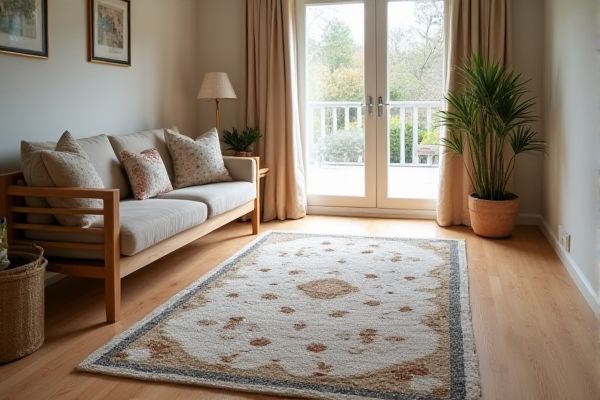
Mat runners provide a durable, low-maintenance option ideal for high-traffic areas, while carpet runners offer a softer, more decorative look that enhances warmth and comfort underfoot. Explore the rest of this article to discover which runner best suits your home and lifestyle needs.
Table of Comparison
| Feature | Mat Runner | Carpet Runner |
|---|---|---|
| Material | Rubber, vinyl, synthetic fibers | Wool, nylon, polyester |
| Purpose | Water and dirt protection, non-slip | Decorative, comfort, noise reduction |
| Placement | Entryways, kitchens, bathrooms | Hallways, staircases, living rooms |
| Durability | High resistance to moisture and wear | Moderate, depends on fiber type |
| Thickness | Thin to medium | Medium to thick |
| Maintenance | Easy to clean, often machine washable | Requires vacuuming and occasional professional cleaning |
| Design Options | Simple, functional | Wide variety of patterns and colors |
| Price Range | Low to moderate | Moderate to high |
Introduction: Mat Runner vs Carpet Runner
Mat runners and carpet runners serve distinct purposes in home decor and functionality, with mat runners typically designed for high-traffic areas to trap dirt and provide slip resistance, while carpet runners prioritize comfort and aesthetic appeal along hallways or stairs. Your choice depends on the environment and usage, where mat runners offer durability and easy cleaning, and carpet runners add warmth and style. Both options enhance floor protection but cater to different needs and design preferences.
Definition and Purpose of Mat Runners
A mat runner is a long, narrow floor covering designed primarily for functionality, providing non-slip surface protection in high-traffic areas such as hallways and entryways. Carpet runners share a similar shape but emphasize decorative appeal, enhancing the aesthetic of staircases or corridors while offering comfort underfoot. Both serve to protect flooring from wear and tear, yet mat runners prioritize durability and safety, whereas carpet runners balance protection with style.
Definition and Purpose of Carpet Runners
Carpet runners are narrow, elongated rugs designed to protect high-traffic areas such as hallways and staircases while adding aesthetic appeal and warmth. Unlike mat runners, which primarily serve as entrance mats to trap dirt and moisture, carpet runners offer cushioning underfoot and enhance interior decor. Their durable construction and variety of materials make carpet runners ideal for both residential and commercial spaces requiring both functionality and style.
Material Differences: Mat Runner vs Carpet Runner
Mat runners are typically made from durable materials such as rubber, vinyl, or coir, designed to withstand heavy foot traffic and provide moisture absorption. Carpet runners, on the other hand, are crafted from woven fibers like wool, nylon, or polyester, offering a softer texture and enhanced aesthetic appeal. The material composition directly impacts durability, maintenance requirements, and suitability for indoor or outdoor use, distinguishing mat runners from carpet runners in practical applications.
Design and Aesthetic Appeal Comparison
Mat runners typically offer simple, durable designs ideal for high-traffic areas, emphasizing functionality over style. Carpet runners provide a wider variety of patterns, textures, and colors, allowing you to enhance your space's aesthetic appeal and complement your interior decor. Your choice between the two should balance practicality with the desired visual impact based on the room's design theme.
Durability and Longevity: What Lasts Longer?
Mat runners typically offer superior durability due to their denser construction and use of synthetic fibers designed to withstand heavy foot traffic and resist staining. Carpet runners, while providing aesthetic warmth and softness, generally wear out faster in high-traffic areas because natural fibers and looser weaves are more prone to fraying and soiling. For long-term use in entryways or hallways, mat runners are often the preferred choice for maintaining longevity and ease of maintenance.
Maintenance and Cleaning Requirements
Mat runners generally require less maintenance than carpet runners due to their durable materials like rubber or vinyl that resist stains and moisture. Carpet runners need regular vacuuming and occasional deep cleaning to prevent dirt buildup and maintain fibers, especially in high-traffic areas. Both types benefit from spot cleaning, but carpet runners may demand professional cleaning services periodically to preserve appearance and longevity.
Placement and Functional Uses
Mat runners are typically placed in high-traffic areas such as entryways, kitchens, or hallways to trap dirt and moisture, offering slip resistance and protecting floors. Carpet runners, often used on staircases or along corridors, provide cushioning, noise reduction, and aesthetic appeal while also preventing wear on underlying flooring. Both serve distinct functional uses based on placement, with mat runners prioritizing cleanliness and safety and carpet runners enhancing comfort and decor.
Cost Comparison: Mat Runner vs Carpet Runner
Mat runners generally cost less than carpet runners due to their simpler materials and easier installation process. Carpet runners, made from woven fibers or synthetic blends, tend to be pricier because of their durability and extensive design options. Your choice will depend on budget constraints and the desired aesthetic impact in your space.
Choosing the Right Runner for Your Space
Mat runners offer lightweight, easy-to-clean solutions ideal for high-traffic areas with frequent dirt and moisture, while carpet runners provide plush comfort and enhanced insulation suitable for hallways and staircases. Consider material durability, maintenance requirements, and the specific function of the space when selecting between a mat runner and a carpet runner. Prioritizing factors such as slip resistance, thickness, and aesthetic compatibility ensures the runner enhances both safety and style in your environment.
 homyna.com
homyna.com